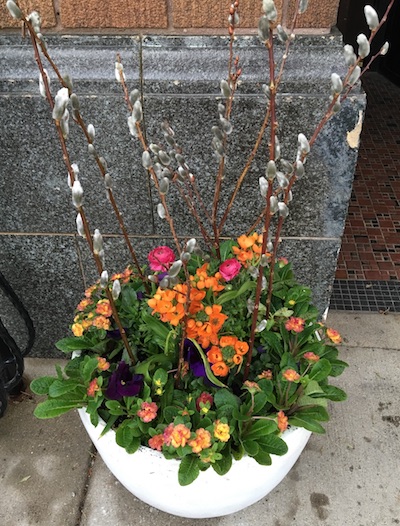
Orange sunstars (Ornithogalum dubium) and pink ranunculus form the centerpiece of this spring container. A ring of purple pansies is followed by Bellarina Nectarine, a double primrose. (C) Photo courtesy Jo Ellen Meyers Sharp
If you’ve ever had a desire for an easy-peasy DIY, a spring container brings the perfect opportunity.
Colorful spring annuals fill garden centers this time of year. These annuals thrive in pots, window boxes and other containers. Embrace the season with a pot of spring flowers by the front door, on a porch step, on the deck or patio, or set one by the mailbox.
More than pansies for spring container
Of course, pansies are perfect for a spring container, along with their cousins violas or Johnny jump-ups. Sweet alyssum is another wonderfully fragrant plant and so is nemesia. Look for the heat-tolerant Blood Orange nemesia for long-lasting, slightly trailing flowers throughout spring. Consider putting a pot of the colorful cool-season annuals where you can enjoy their sweet fragrance when you walk by.
But garden centers have even more beauties for a spring container:
- Ranunculus has flowers that look like ball of tissue paper-like. They come in many colors, and they work well as a centerpiece in a spring container.
- Heath is an unusual plant for Indiana gardeners. A small shrub, you can find his in 4- or 6-inch pots this time of year for spring container. The flowers are pink and the soft, evergreen foliage adds wonderful texture to a pot. Although these are winter hardy in the Indiana landscape, heaths and heathers are usually pretty unhappy with our heavy clay soils. Retain them for use in a summer container and enjoy them for however long they last.
- Snapdragons, stocks and wallflowers also can be found in garden centers. These, too, make good candidates for centerpieces in a spring container or background in a window box.
- Gerber daisies can handle cool spring temperatures and they come in many colors. These plants tend to fizzle out a bit once summer temperatures arrive, then revive when temps drop in fall.
- Look for daffodils, tulips, hyacinths and crocus that have been forced to bloom to add spring bulbs to your container. Transplants the bulbs to the garden when they are done blooming.

Stocks form the background with pansies and heath. Spanish moss give the spring container a finished look. (C) Photo courtesy Jo Ellen Meyers Sharp
More than annuals for spring container
Several perennials are perfectly happy in a spring container, too, including coral bells, hellebores, primroses, mini roses and sedges. The nice thing about many of these perennials is they can stay in the pots well into fall, even winter. Perennials can be transplanted to the ground at the end of the growing season, if desired.
The foliage of native coral bells (found only in North America) is varied and beautiful. Coral bells tolerate shade to full sun. They bloom in late spring and mid- to late summer. Bell-shaped flowers dangle from stalks that emerge from the center of the plant. Hummingbirds love coral bells.
Hellebores are the evergreen perennials that carry gardeners through winter. Depending on the type, hellebores bloom in the Indiana landscape winter into summer. Shade tolerant and adaptable to dry soils, hellebores thrive in morning sun and with regular watering.

A pink mini rose is a companion to pansies and trailing green and white ivy. Pussy willow branches add height and Spanish moss finishes it off. (C) Photo courtesy Jo Ellen Meyers Sharp
Known for their blooms in the landscape, primroses do well in a spring container, too. Mini roses are perfectly winter hardy in the Indiana landscape and they do well in containers through the seasons, too. Treat them like any other rose.
Sedges, sometimes sold as Carex, its scientific name, contribute color and grass-like texture to containers. Many sedges are hardy in the Indiana landscape, including several native ones. The gardens at Newfields have sedges, making them a great place to see how they (and other plants) look in a landscape or containers.
Other tips for spring containers
For best results, use a high quality potting mix in containers, whether for spring or any other season. These are formulated for good drainage and are lightweight.
If you have a pot that has potting mix in it from last year, use it for spring flowers, if there were no insect or disease problems.
Pansies do best when spent flowers are removed. Violas tend to take care of themselves and require little maintenance.
Water your spring container as needed. Fertilizer is usually not necessary since the plants are in pots for such a short time.
Of course, your Holeman professional will be happy to help you with your spring container or pots for any season.
